Heading out the door? Read this article on the new Outside+ app available now on iOS devices for members! Download the app.
Frontside skis with waist widths between 80-90 millimeters generally fall into two types: ones that blur the line between carving skis and all-mountain skis, and others that lean into leaving trenches in the snow. We evaluated both kinds at our 2024 Ski Test at Mt. Rose, Nevada, favoring those that stood out for their carving skills, edge grip on hardpack, and ability to handle some off-piste, too.
Looking at the winners this season, it’s easy to see a common thread: updates to ski shapes and construction aimed at making skis easier to turn, and therefore more accessible for a wider range of skiers. One or two beefy daily drivers still made our list, but skiers will find plenty of choices to suit any skier style in this year’s crop of the best frontside skis.
The skis on this list appear in ranked order, with the ski that tested best at our 2024 Ski Test at Mt. Rose listed at the top. We believe the skis listed in this round-up set the benchmark for what a frontside ski is designed to do.
That said, remember that ski testing (and skiing) is somewhat subjective. While we’re big fans of the category-winning Rossignol Arcade 88, it may not be the best choice for every skier. So don’t just look at a ski’s score—read our testers’ feedback to understand the nuances of each ski and who it’s best suited for. Otherwise, you might wind up with a great ski that’s not the right ski for you.
Looking for the best women’s frontside skis? You’ll find those here.
At a Glance
- Best in Test: Rossignol Arcade 88 ($850)
- Best for Chargers: Völkl Mantra 88 ($449)
- Most Versatile: Dynastar M-Cross 88 ($422)
- Best Value: Nordica Enforcer 89 ($490)
- Fischer The Curve GT 85 ($950)
- Stöckli Montero AR ($1,829)
- Blizzard Anomaly 88 ($700)
- Salomon Stance 90 ($490)
- Armada Declivity 82 Ti ($525)
- Black Crows Octo ($630)
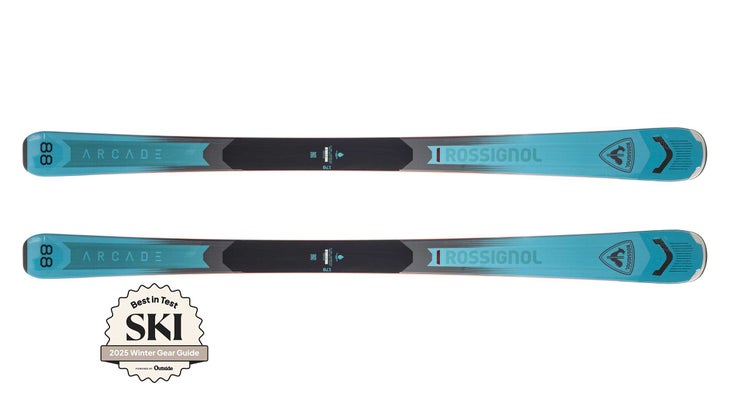
1. Best in Test
Rossignol Arcade 88
Score: 8.38/10
Dimensions: 135-88-124 mm
Lengths: 154, 162, 170, 178, 186 cm
Turn Radius: 15 m (178 cm)
Weight: 1,750 g (178 cm)
Pros and Cons
⊕ Intuitive edge hold
⊕ Cat-like reflexes
⊗ Unforgiving if you get in the backseat
⊗ Crud is not its jam
The all-new Arcade 88 hit the jackpot in this year’s test, not only winning Best in Test after impressing testers across the board, but also snagging the highest category scores in our carving, quickness, and playfulness criteria.
Testers agreed that this versatile frontside ski will speak to a wide range of skiers—from intermediates to experts—looking for a narrower all-mountain tool that excels on groomers but is quick and dependable enough to make variable terrain and snow fun, too.
“This is a perfect specimen of a frontside carver,” Chad Jacob, a race coach and longtime New York-based tester, said about the Rossignol Arcade 88. “It’s damp, responsive, energetic and strong.”
Rossignol’s new Arcade series consists of two models, the 88 and the slightly narrower 84, which replace the sub-90-millimeter waist widths from the Experience line (the women’s Experience line carries forward). The Arcade 88 has the bells and whistles of a high-performance carving ski—a full layer of Titanal, vibration absorption technology, and a central power rail down the wood core—along with an extended sidecut and tip rocker, which helps it perform like a wide carving ski.
“It holds a wicked turn,” said Luke Larsen, co-owner of the Lifthouse Ski Shop in Salt Lake City, UT. “The Arcade will keep the carver party rolling until last chair.”
Testers were hard-pressed to find a weakness in the Arcade 88, though they gave it slightly lower scores for crud performance and forgiveness.
“The energy that makes the Arcade 88 so much fun is also what you have to be careful of,” said Jon Sexauer, a five-foot-seven Colorado-based tester. “It demands a confident and technically proficient skier to maximize the ski’s strengths.”
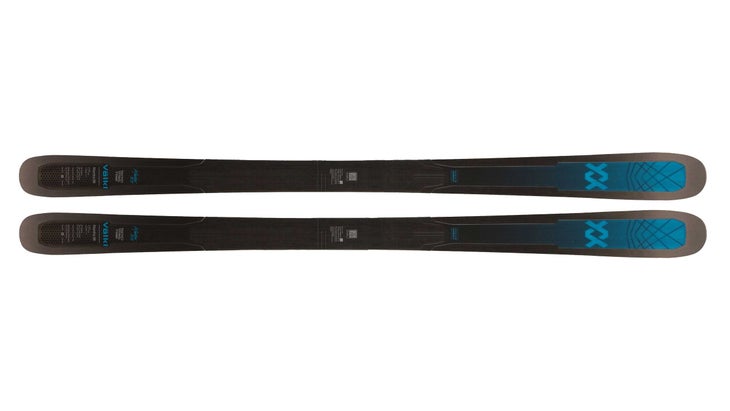
2. Best for Chargers
Völkl Mantra 88
Score: 8.29/10
Dimensions: 129-88-113 mm
Lengths: 163, 170, 177, 184 cm
Turn Radius: 16 m (177)
Weight: 1,900 g (177)
Pros and Cons
⊕ Sticks to groomers like glue
⊕ Stability increases with more edge angle
⊗ Tails don’t smear
⊗ Too carve-focused for off-piste
Like the Rolling Stones, the Völkl Mantra family keeps rocking and now absorbs the perennial favorite Kendo 88 as the Mantra 88 without any construction changes. Not surprising for a Völkl ski, the Mantra 88 earned top category scores for hard-snow integrity, stability at speed, and responsiveness at our Mt. Rose test.
Incorporating the damp and stable feel of previous Mantra models, this 88-millimeter-waisted version impressed us with its edge hold and turn shape versatility. “On a scale of 1-10, these skis go to an 11,” said Luke Larsen, a forty-year-old Utah-based tester. “It’s the perfect ski for trenching groomers on any mountain.”
Völkl’s recent updates include Tailored Carbon Tips and a 3D Radius Sidecut that makes the turn radius longer in the tip and tail and shorter underfoot. Testers detected vibration from the carbon fiber tips that was pervasive in bumpy conditions, as well as noted tail performance bent on railing turns and not smearing.
We recommend the Mantra 88 for carvers in the Northeast who want a wider platform underfoot, or “as a low-tide stick for the West,” as tester and Outside’s digital editor Jake Stern put it.
“You can feel the G forces as the edges hook up,” said Otto Gibbons, a five-foot-six Washington-based tester. “It takes a couple turns to understand what the 3D radius will do, but it can be broken down into three parts: Here, There, and Gone.”
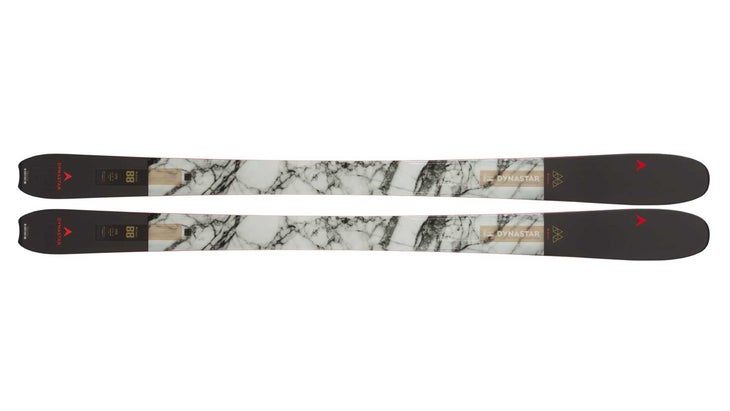
3. Most Versatile
Dynastar M-Cross 88
$422 (without bindings) at REI
Score: 7.82/10
Dimensions: 135-88-117 mm
Lengths: 159, 168, 176, 184 cm
Turn Radius: 14 m (176 cm)
Weight: 1,800 g (176 cm)
Pros and Cons
⊕ Great balance of energy and stability
⊕ Exceptionally versatile
⊗ Stiff tail decreases playfulness
⊗ Very directional
The Dynastar M-Cross 88 is the Switzerland of frontside skis, staying neutral between carving up groomers and exploring off-piste. “Loves chewing up fresh corduroy, but feels at home picking up leftovers off trail, too,” noted Utah-based tester Luke Larsen. In fact, it’s so well balanced testers gave it top marks in the versatility criteria, along with high scores for quickness.
“This is a great ski for instructors, coaches, and ski patrollers who want a daily driver between storms,” said Jon Sexauer, a 37-year-old Colorado-based tester. “It’s quick and nimble from edge to edge, which is helpful in both varied terrain and on groomers.”
According to testers, intermediate skiers can benefit from the M-Cross 88’s confidence-boosting balance, while experts can appreciate the rebound energy. The ski’s voluminous 135-millimeter tip helps with turn entry and flotation in cutup snow, and the sidewall construction adds grip on the groomers.
Testers gave the M-Cross 88 lower scores for playfulness due to the stiff tail, which helps with a smooth release of the turn but is not forgiving of pilot error. “It’s a very directional ski that can break a bit at the bottom of the turn,” said Chad Jacob, a New York-based race coach. Brady Newton, a 6-foot-1 tester from Utah, said staying centered is key: “Stand on it and you’ll find a stable and compliant platform to explore the whole mountain.”
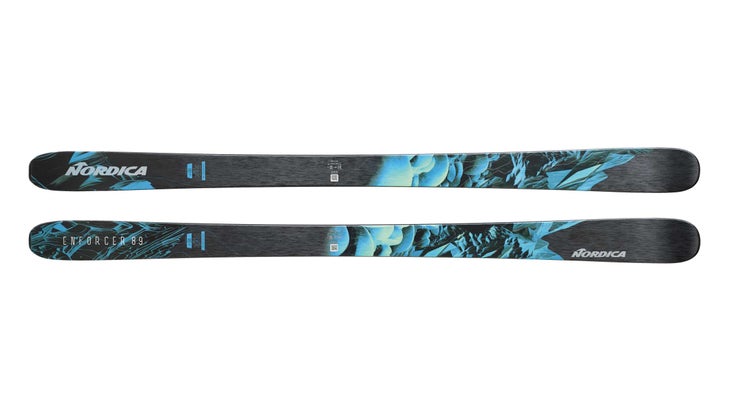
4. Best for Crud
Nordica Enforcer 89
Score: 7.8/10
Dimensions: 121.5-89-109.5 mm
Lengths: 167, 173, 179, 185 cm
Turn Radius: 17 m (173 cm)
Weight: 2,010 g (173 cm)
Pros and Cons
⊕ Can charge or cruise
⊕ Quick and responsive
⊗ Demanding
⊗ Loose tail hold at end of the turn
The Enforcer line, like a good jam band, has had a long illustrious career with a lot of followers. Hardcore Enforcer enthusiasts gravitated to the old Enforcer 88 for its carving performance, but not every skier could handle the burly construction. The new Enforcer 89 upgrades the 88’s shape and technology and retains its strong carving performance, but is now more accessible to lesser experts and more adept off-trail.
“This new iteration is still an aggressive ski, but it’s slightly more approachable,” said Nick Loomans, a six-foot expert skier. “It has great balance, energy and an aggressive grip.”
The redesign includes tweaks to the rocker profile—specifically more tail rocker and less tip rocker—which creates a quicker release of the turn, as well as two full-length layers of Titanal and a layer of vibration-absorbing elastomer underfoot. Its no-nonsense construction and adaptable shape earned it high marks in hard-snow integrity, stability at speed, and above-average marks in versatility.
“It carves like a fat race ski and is still responsive off trail,” noted tester and ski shop owner Luke Larsen.
What hasn’t fully changed, according to testers, is that the Enforcer 89 is still a demanding ski, and it can overwhelm less aggressive skiers. Enforcer-heads can rest assured that the ski didn’t lose performance—it gained more range.

5. Fischer The Curv GT 85
$950 at Amazon $950 at Ski Essentials
Score: 7.7/10
Dimensions: 133-85-118 mm
Lengths: 161, 168, 175, 182 cm
Turn Radius: 15 m (175 cm)
Weight: 2,320 g (175 cm)
Pros and Cons
⊕ Loves to lay trenches on the groomers
⊕ Wide tip intuitively enters the turn
⊗ Demands carving territory
⊗ Not the best in crud
⊗ Pricey
Testers decided that the Curve GT 85 is really more of a carving ski disguised as a frontside tool. “It’s a great ego-boosting carver,” reported five-foot-ten Utah-based tester Luke Larsen. “It easily dives into a turn and rolls over from edge to edge with very little effort.”
Indeed, the Curv GT 85 received high scores for carving and hard-snow integrity, and testers appreciated the ski’s accessibility for a range of ability levels. “It’s a wide carving ski that’s easy to have fun with,” said Otto Gibbons, a Washington-based tester. “Plus, it offers good turn shape versatility.”
The Curv GT 85 has a curvy profile, with one of the widest tips in the category, which testers said enhanced maneuverability. Fischer’s Shaped Ti adds a milled layer of Titanal to the sandwich sidewall construction and Fischer’s E-Triple Radius creates a stiffer flex underfoot with a softer flex in the tips and tails for quick turn transitions.
The Curv GT 85’s greatest strength can also be a weakness if you’re looking for off-piste performance.: “It’s a bit of a one-trick pony—carve, carve, carve,” said Todd Casey, a ski instructor from Colorado. Testers gave it lower scores for crud performance, cautioning skiers not to look for cutup stashes off the trail. Keep it on the groomers, however, and this ski will live up to its name.
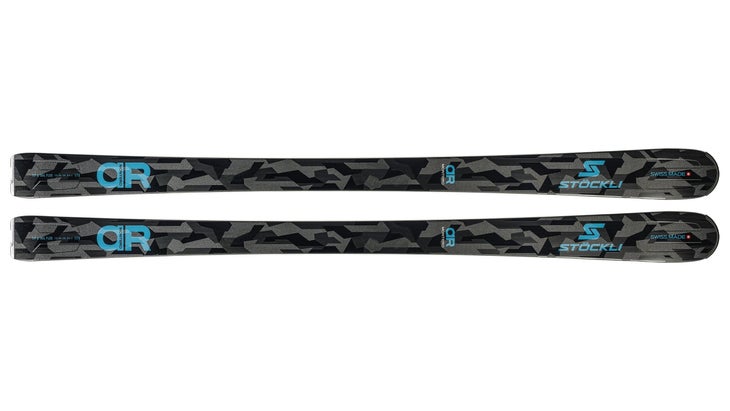
6. Stöckli Montero AR
$1,829 (with bindings) at Utah Ski Gear
Score: 7.69/10
Dimensions: 128-84-114 mm
Lengths: 165, 170, 175, 180, 185 cm
Turn Radius: 16.3 m (175 cm)
Weight: 1,915 g (175 cm)
Pros and Cons
⊕ Eats corduroy for breakfast
⊕ Race-like edge grip
⊗ Expensive
⊗ Lacks off-piste performance
The Stöckli Montero AR looks like a set of railroad tracks with its metal-colored aesthetic, which is fitting, since these things are designed to leave precise tracks in the snow.
“This is a retail race carver that’s been softened up and made more approachable,” said Chad Jacob, a New-York based race coach. “I was surprised by how smooth and quiet it felt in a long radius turn.”
An 84 millimeter waist width and long rocker in the tail increases the Montero AR’s versatility, while the race-oriented construction and Stöckli’s Full Edge Contact adds edge grip in long turns.
According to testers, the Montero AR shines brightest in the hard-snow integrity and carving categories, capable of moving across the fall line with “a ton of energy out of each turn,” said Jake Stern. “If you like to spark arcs and rail your turns, this ski is for you.”
If you’re looking for off-trail performance or a tight turn radius, look elsewhere; testers were not as impressed with this ski’s handling off the groomed and felt that, though more accessible than a pure race ski, it’s not forgiving.
“If you love to arc smooth, fast, aggressive medium-to-long radius turns down the frontside, look no further,” said Brady Newton, a six-foot-one expert skier. “I set an edge and blinked, and the run was over.”
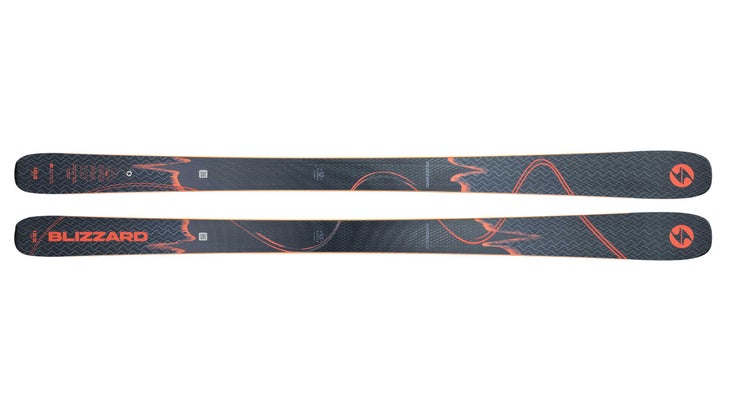
7. Blizzard Anomaly 88
Score: 7.65/10
Dimensions: 127.5-88-109.5 mm
Lengths: 164, 170, 176, 182, 188 cm
Turn Radius: 16.5 m (176 cm)
Weight: 2,000 g (176 cm)
Pros and Cons
⊕ Crushes high-speed turns on groomers
⊕ Great edge grip
⊗ Stiff and aggressive
⊗ Strictly business
The new Anomaly 88 is like a good coach: demanding, serious, and dependable. It also opens up the playing field. “This is a powerful ski that’s more accessible than the Brahma,” said Jake Stern, a five-foot-eleven expert skier. “It’s built for advanced through expert skiers who want a little off-piste versatility with their frontside skis.”
Testers gave the 88-millimeter-waisted ski top marks for hard-snow integrity and stability at speed. “The edge hold was incredible and the energy out of the turn felt so fun,” said Chad Jacob, a New-York based tester. The Anomaly 88’s precision and frontside versatility comes from the combo of Blizzard’s Trueblend all-mountain wood core that’s stiffer underfoot and softer in the rockered tips and tails, plus the FluxForm multi-metal layup that’s sized specifically for each ski length.
The result? “This ski is strictly business and might be too stiff for less aggressive skiers,” noted Nick Loomans, a six-foot Utah-based tester. “It may be a little heavy carrying it to the bar,” quipped Charlie Bradley, a bootfitter from Taos, N.M.
Blizzard’s goal with the Anomaly 88 was to bridge frontside and all-mountain performance, but the ski’s happy place, according to testers, is wide-open groomers where it can tip and rip.
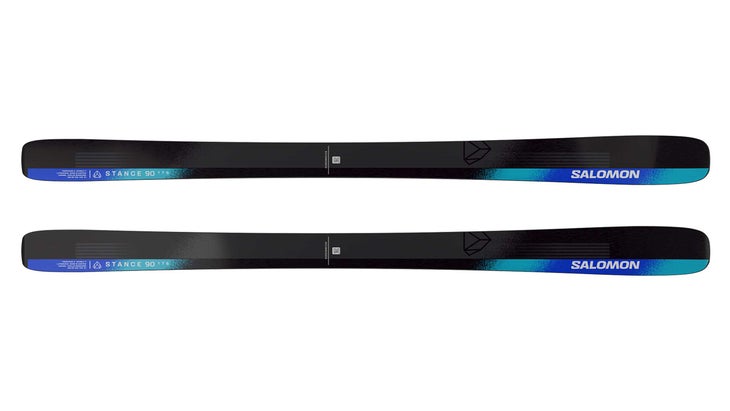
8. Salomon Stance 90
Score: 7.56/10
Dimensions: 126-90-108 mm
Lengths: 168, 176, 182, 188 cm
Turn Radius: 18 m (176 cm)
Weight: 1,770 g (176 cm)
Pros and Cons
⊕ Easy to ski at all speeds
⊕ Stable and smooth
⊗ Lacks rebound energy
⊗ Feels lightweight in crud
The Salomon Stance 90 is so balanced, it’s basically a Zen practitioner. “This ski is calm and stable,” said Nick Loomans, a Utah-based expert skier. “It’s best for intermediate and advanced skiers who want to be in the moment and get predictable performance without too much energy from the ski.”
Testers gave the newly-updated Stance 90 top marks for its versatility and hard-snow integrity, and noticed more user-friendly attributes than previous models—including easy turn initiation and a big sweet spot underfoot. Those improvements can be traced to a lighter weight construction of a poplar and caruba wood core that still integrates two sheets of Titanal and race-like sandwich sidewalls for great stability and edge performance.
Testers felt that the 90-millimeter-waisted ski favored groomed and ungroomed snow equally, making a great “in between storms” ski for a wider range of ability levels. But it’s not the most exciting or lively ski in the bunch, and some ex-racers of the group found the lack of rebound energy to be, well, boring. “Even with its lighter weight chassis, it can feel sluggish,” observed Rob Hudson, a Colorado-based expert tester.
But the majority of our test crew thought the Stance 88 would make a great frontside tool for the masses. “It’s a very stable cruiser that carves equally well at low angle and slow speeds as it does at higher speed in the steeps,” summed up Chad Jacob, a five-foot-ten race coach from New York.
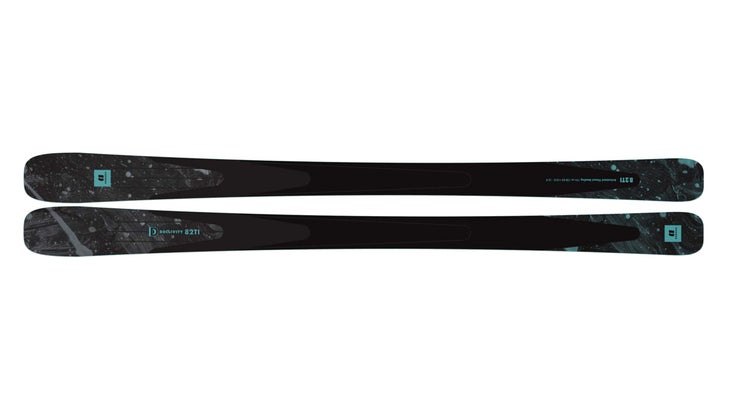
9. Armada Declivity 82 Ti
Score: 7.2/10
Dimensions: 128-82-110
Lengths: 166, 174, 182
Turn Radius: 15.9 m (174 cm)
Weight: 1,800 g (174 cm)
Pros and Cons
⊕ Approachable
⊕ Stiff tail adds strong finish to the turn
⊗ Soft tip lowers confidence on steeps and ice
⊗ Might be too directional for some
Armada may have started as a freestyle brand, but with the Delivity 82 Ti, it created a serious narrow-waisted carver that has proven itself against the most traditional and directional frontside sticks.
“The Armada Declivity 82 Ti has a fun, directional approach to the mountain,” said Jon Sexuaer, a Colorado-based tester. “Intermediates through experts can enjoy turn shape versatility on the groomers, while still allowing for skids and slashes.”
The Declivity 82 Ti enters a turn easily yet holds well throughout the arc, something testers rewarded by giving it high scores for carving and forgiveness. Armanda’s freestyle heritage is exemplified by tip and tail rocker and a soft flexing at the front of the ski. The serious side comes from the full-length sidewall construction and full layer of Titanal. “It’s not a high-energy ski, which is why it scores lower for playfulness,” said Rob Hudson, a five-foot-nine tester. “It skis well, but it’s not going to let you bend it with a ton of forward pressure.”
Testers felt the soft profile lowered the Declivity 82 Ti’s performance on steep terrain and ice, but increased its versatility. “At its core, it’s a damp and smooth performer that takes very little effort to have fun on,” said Chad Jacob, a New York-based tester.
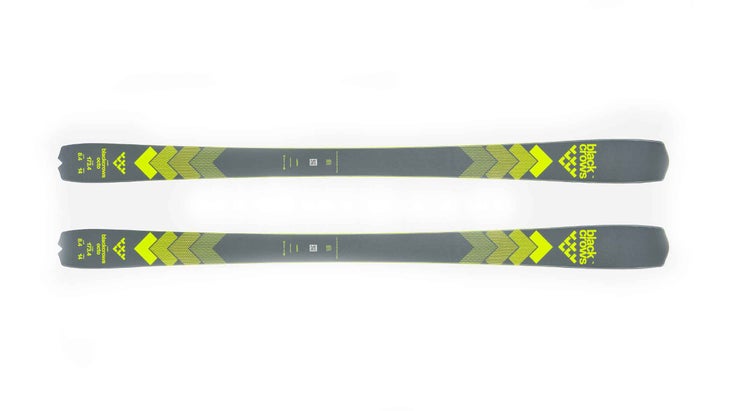
10. Black Crows Octo
Score: 6.8/10
Dimensions: 127-84-114 mm
Lengths: 167, 173, 179, 185 cm
Turn Radius: 14 m (173 cm)
Weight: 1,550 g (173 cm)
Pros and Cons
⊕ Light underfoot
⊕ Exceptional maneuverability
⊕ Unique new school-meets-traditional design
⊗ Can be overskied by aggressive skiers
⊗ Not enough backbone for charging steeps, speed, and crud
If you’re looking for a ski that won’t drain your legs and lets you ski all day, look no further. “The Octo is like an old friend,” said Luke Larsen, a Utah-based expert skier. “It lets you enter and exit the turn when you want to. It’s a real confidence-booster.”
The new Black Crows Octo combines a classic frontside ski construction with a profile inspired by the brand’s freestyle focused Mirus Cor, which has a distinctive swallowtail.
“The Octo seems like a ski designed to put a spring in your step—or turn in this case,” said Otto Gibbons, a Washington-based bootfitter. “It’s maneuverable edge-to-edge, and even in the shorter length, it could still arc.”
The 84-millimeter-waisted Octo has a poplar wood and fiberglass core with aluminum tail inserts, but otherwise no metal, making it significantly lighter and softer than other skis on this list.
The upshot to that pared-down construction is a ski that’s quick, playful, and easy to turn; the downside is the ski lacks the kind of backbone to tackle hard snow, crud, and speed with confidence. The bottom line, according five-foot-nine tester Rob Hudson: “This ski is fun, quick and light underfoot, and allows a wide range of skiers to enjoy numerous parts of the mountain.”
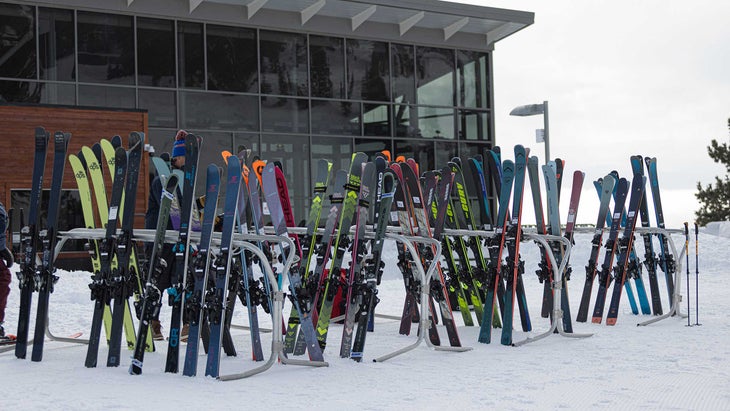
How We Test
- Number of frontside skis tested: 15
- Number of testers: 15
- Testing location: Mt. Rose, Nevada
- Average age of tester: 37
- Average height of tester: 5’10”
- Average weight of tester: 182 lbs
SKI has been running its annual ski test for decades now, but we’re always tweaking and perfecting the process. Last March, we invited a crew of seasoned industry professionals—ski instructors, ski shop employees, coaches, and outdoor industry professionals—to join us for a week-long gear test at Mt. Rose, Nevada, a lesser-known ski area in the Tahoe area with some seriously fun terrain.
The mission: Jump on every pair of skis entered into our five categories (Carving, Frontside, All-Mountain, All-Mountain Wide, and Powder), put them through their paces all over the mountain, and then fill out a digital scorecard with comments and impressions of how each pair of planks performed across various skill categories—from carving chops and crud performance to stability at speed and responsiveness.
We ask our crew of 27 testers to identify a ski’s primary strengths, its weaknesses, who it’s designed for, and what terrain and snow conditions it’s most adept at. At the end of the week, we have enough hard data on the 100-plus pairs of skis tested to make your head spin, and we use it all to bring you these reviews of the best skis of the year.
When judging a frontside ski, testers primarily assess how well it performs on groomed terrain, since this is what this type of ski is primarily designed for. They gauge how well the ski handles on hard-snow, at speed, and how responsive it is from edge to edge.
The skis on this list impressed us most across the nine different scoring criteria of the Frontside category:
- Hard-Snow Integrity
- Stability at Speed
- Carving
- Responsiveness
- Quickness
- Playfulness
- Crud Performance
- Versatility
- Forgiveness
Learn more: Understanding Ski Test Scoring Criteria
Meet the Testers
Krista Crabtree
Age: 50 | Height: 5’8″ | Weight: 130 lbs
Crabtree spent every winter weekend brown-bagging lunch and skiing bell to bell in New Hampshire and ski racing around New England’s storied race hills. After a stint on the Bates College alpine ski team, she headed west to coach at Ski Club Vail, and then moved to the mountains above Boulder to get her Masters at the University of Colorado. An internship at SKI lead to eight years as an editor and director of the women’s ski test. She has been testing and writing about skis, boots, and gear since 1999.
Otto Gibbons
Age: 25 | Height: 5′6″ | Weight: 130 lbs
Gibbons has spent 22 of his 23 years on this earth on skis. The son of Sturtevants Sports’ head buyer, Tracy Gibbons, Otto has basically lived in the ski shop his whole life and has worked there for the past seven years as a hardgoods buyer. If he’s not in the shop, he’s ripping laps at Washington’s Crystal Mountain.
Chad Jacob
Age: 42 | Height: 5’10” | Weight: 210 lbs
Jacob is a ski race coach from the East Coast and skis like one. At his home hill of Bristol Mountain, N.Y., you’ll likely find him carving up icy groomers on a set of skinny skis. Jacob is a veteran gear tester who has tested skis for Outside and SKI.
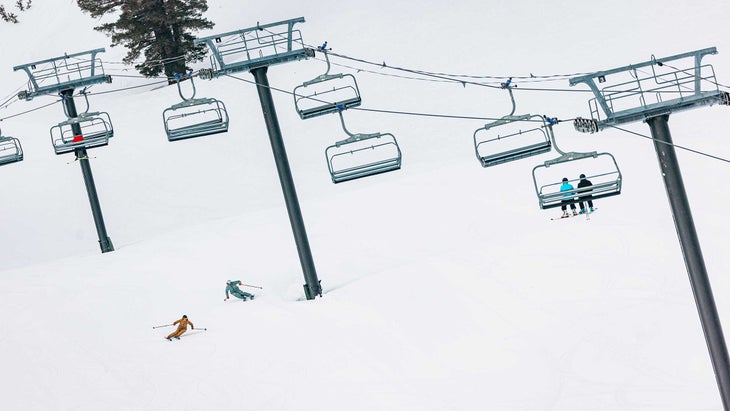
Frequently Asked Questions
What Are Frontside Skis?
Do-it-all skis with middle-of-the-road waists (80 millimeters to 90 millimeters), a moderate rocker profile (primarily in the tip), camber underfoot, and typically, a flat tail. This kind of profile orients these narrow all-mountain skis towards the frontside of the mountain, and these skis generally perform best on groomed terrain, though they’re also versatile enough to tackle bumps, crud, and tree skiing. While rockered tips add some versatility, these skis are not designed to be skied in deep powder.
What’s the Difference Between Carving Ski and Frontside Skis?
Carving skis give it away in the name: They’re designed to rip down groomed terrain. Think of them as race skis that were made more accessible to the everyday skier and everyday skiing.
Frontside skis can be just as reliable on groomers and hardpack, even with a little added tip rocker. But because frontside skis are typically a little straighter from tip to tail with a slightly wider waist, they don’t have the same innate carving capabilities as carving skis. Where frontside skis win out is in the versatility department—they’re designed to perform even off the groomers.
In short: Carving skis are the scalpels of skis, designed to be handled by an experienced hand and leave precise incisions on the snow. A frontside ski is more like a machete—it’s still sharp and effective but doesn’t require you to be as precise in your cutting. Read more here.
What’s the Difference Between Men’s and Women’s Skis?
In truth, most skis are unisex and not gender-specific. Many brands produce the ski with the exact same construction technologies for both genders, but often create two different top sheets to appeal to men vs. women.
A handful of brands are making truly women’s-specific skis, where the ski takes a woman’s physique into account when building the ski. Men and women can ski on the same ski but may want to choose different lengths depending on their height and their skiing ability.
